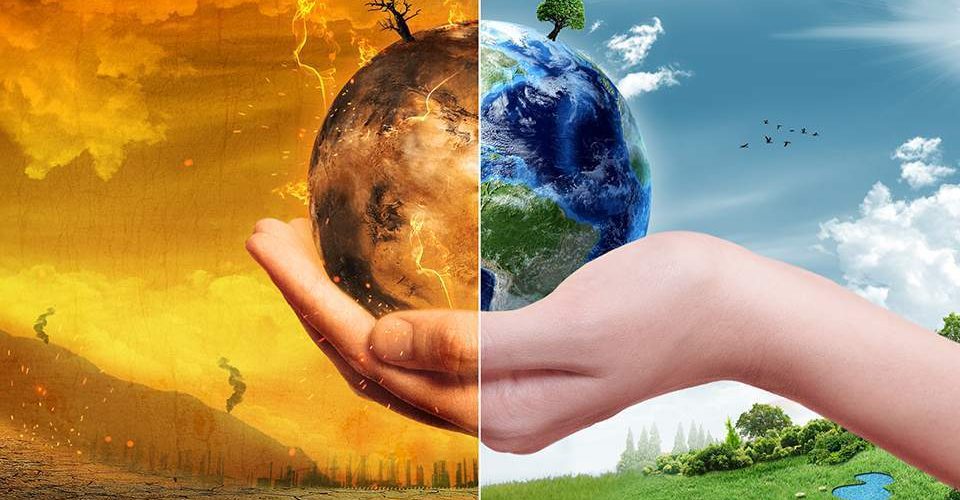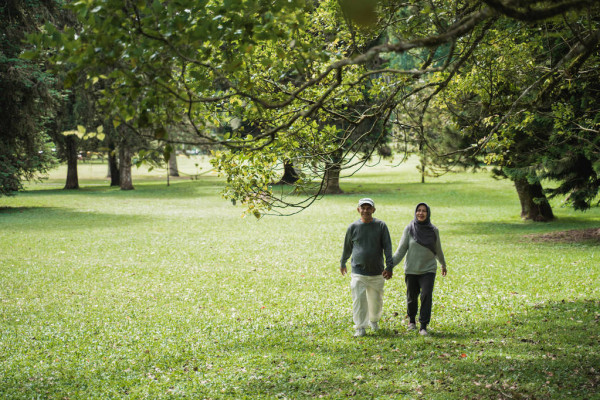Conscious Living – As We Heal The Earth, The Earth Heals Us
- December 1, 2020
- Posted by: admin
- Category: Featured Content,

By Nicole Yong.Y.Y
When science started opening new prospects of knowledge with the advent of the Industrial Revolution, almost all ecosystems were changed by human activities. Over destruction of forests for urban development, industrial farming and deplorable modern methods of raising livestock, factories, mega-dams and power plants are increasing now. The waste material generated by technological and scientific processes severely pollute the soil, river, ocean and air.
Although there are certain laws and rules to enforce the protection of reserve jungles and waste management, they are not strict enough. The short sighted powerful individuals or corporations, which have no moral restraint, are greedy for quick and huge profits. They disrupt the ecological balance and not only pollute the physical environment and contribute to global warming, but also put human health at risk.
These days, the environmental NGO researchers have been increasingly drawn towards understanding how global warming, ultraviolet effect and habitat loss may cause destruction in species’ lives and extinction of species; and the worst is the rise of diseases and pandemics.
Loss of Morality and Rise of Pandemics
The destruction and degradation of forests cause global warming. They lead to changes in vegetation and animal life and cause diseases to spread faster. Changes in land use consequently bring wildlife, livestock and humans into closer contact with each other and aid the spread of diseases.
How? The destruction and degradation of forests cause a reduction in natural habitats, and the animals and species have to live closer than ever to one another and to humans. When the ecosystems are damaged, there’s a risk of viruses from animals looking for new hosts – us. For example, history shows that deforestation increases the Malaria and Ebola disease outbreak rates as humans come into close contact with previously untouched wildlife.
The wild landscapes used for industrial farming bring risks as well. When thousands of animals are put in a very small space and do have not many places to move, the high humidity and temperature increase the animals’ chances to fall sick. And each time viruses spread among animals, they may result in a faster spread in the small space. When these animals come into contact with humans, diseases such as bird flu, H1N1 and tuberculosis can be transmitted to humans. Meanwhile, the trade of live wild animals brings the dangerous possibility of contact between humans and diseases. It was shown that recent outbreaks of Covid-19 or MERS may have originated in markets that sell a mix of wild and livestock, creating the conditions for the development of outbreaks.
It is the humans’ greed in misusing, exploiting and harming the sacred nature that causes the rise of pandemics, not nature itself.
The air, water and soil are polluted with toxins from modern material living, and we drink, eat and breathe pollution indirectly. Due to this, the human immune system weakens indirectly too. Further serious outbreaks can no longer be ignored as humans have interfered with the forces of nature.
We can see the efforts initiated by some countries and environmental NGOs, such as the enforcement of environmental laws, tree plantations, water management and rejuvenation of rivers, and encourage chemical-free organic farming and the vision to educate children on all these. While they are important, they are not enough to ensure environmental sustainability. We need to care for the environment as a part of our value system. It awakens a sense of belonging and ownership for the planet. We have to realise that we have to care for nature like we care for our own bodies.
Here’s a list of small steps we can take to align our lives with nature and expand our consciousness to completely connect with it. These are the four fundamental areas we can concentrate on:
Yoga Eco-Philosophy - What has it taught us?
Today’s health and economic crisis alerts us to have an urgent need for an in-depth reflection on the relationship between human beings and nature. The pandemic has opened our eyes to respect mother nature.
What is the yogic perspective of nature? As a Jnana Yogi, we have learnt the principles taught in the classic Vedic text Isha Upanishad:
“Īśāvāsyam idaṁ sarvam: a ruling principle pervades the whole Cosmos. ‘Isa’ is the word used in the Upanishad. A controlling, restraining, determining, harmonising and satisfying principle is Isa, or Isvara. All these aspects are present in it. It gives life to all things.” – By Swami Krishnananda.
Upanishad has revealed that the existence of life on earth is part of the universe. No creation is superior to any other. The earth, all the living beings and non-living beings do not belong to humans. Humans are a part of nature. When we examine Patanjali’s Yoga Sutra, which was compiled a few thousand years ago, the first component of the first limb of Yama (right living ethic) is Ahimsa (non-harming).
More than a few thousand years ago, yogis had expressed the value of ahimsa as a core value of philosophy, spirituality and ethics.
Ahimsa is the greatest Dharma (right duty). Yogis honor the natural rhythm. They avoid activities associated with violence or harm, and follow a vegetarian diet. Ahimsa guides us to live in harmony with the laws of nature and respect nature. The ancient sages, rishis and yogis were the original ecologists. They teach us Ahimsa and to respect nature, to ensure environmental sustainability.
Expanding Self Consciousness: Our Personal Green Earth Mission...

★ What we eat
A vegetarian diet reduces personal carbon emissions by more than one tonne per year. It dramatically lowers the environmental impact as raising animals for food requires far more resources in terms of land use and the growth of plants for food of the same caloric value and nutritional content. Study shows that one chicken is able to feed three to four people, but the 50kg of food grains (to raise one chicken), can feed around 400-450 people.
Study shows the production of one kilogram of beef is responsible for as much carbon dioxide emission as driving more than 250km in a car. Imagine, when a majority of people choose vegetarian diets, the cost of combating climate change will drop by 50 percent.
Furthermore, our body is designed for a vegetarian diet. We are like herbivores, our intestines are longer than carnivores’. If we consume meat, the food passes through our intestines much more slowly and takes a longer time to digest. This may take up to 72 hours. In this time, it can rot and cause toxins to build up.
Ayurveda says that this is “Ama” – toxins that build up in the body due to improper diet and improper lifestyle. Ama is the main cause of most diseases as it clogs the body channel and causes an inefficient nutrient delivery to cells. Thus it’s wise to be a vegetarian. It’s even better to support organic fruits and vegetables, and directly or indirectly support non-chemical insecticides and fertilizers farming.
★ How we use energy
We can always choose earth-friendly products or cultivate good habits in our daily lives. We can choose a car with high fuel efficiency and share the ride with others, improve insulation, use a fan instead of air-cond, install timers and motion sensors, air-dry our clothes, use rechargeable batteries, turn off lights during day time, use the solar system and carpool.
For short journeys within 15 to 30 minutes walking distance, we can calculate our carbon footprint and ask ourselves how we can walk more lovingly.


★ Our purchase habits
Reducing, reusing, and recycling are ideal ways to conserve the earth’s resources. We are not minimalists, but simply try to be more conscious of how and what we consume. It can make a world of difference. When we reduce plastic consumption we can beat plastic pollution in the long run; such as bringing our own shopping bags, refuse the use of plastic straws, carry a reusable water bottle, pack lunches with reusable containers, etc.
By the way, we must examine our life values – do we really need to buy so many clothes and fashion accessories, home decoration, home appliances and so on? The answer to all these questions can certainly allow us to think about issues like conservation and renewable sources of energy and reducing our carbon footprint.

★ Nature meditation
We may try to connect with nature through Nature Meditation. Then our mental state becomes calm, the body relaxes and our taste preference changes naturally. Our body desires food that gives a light feeling and moves away from heavy foods that harm our bodies and mental states. Many have gradually become vegetarians after the frequent practice of meditation. Take the following 14-day Nature Meditation practice. This will connect us with nature, let us experience the vital healing energy, deepen our awareness and help us to cultivate positive behavior.
Basic Nature Meditation Practice (with eyes open)
This meditation can be done while taking a slow morning walk in our garden for about 20 minutes.
- Allow the breath to flow gently, walk slowly and be relaxed.
- Focus your awareness on the experience of nature – observe the different colours of flowers, trees, butterflies and birds; listen to the sound of birds and water or stream; feel the gentle wind and warm sunlight; breathe in the fresh air and feel the earth beneath us.
- When the mind wanders and thoughts arise, simply bring them back to the present moment and experience nature.
- Enjoy the complete feel of serenity and rejuvenation.
- After the practice, slowly inhale and bring awareness back to the body and senses.
- Appreciate the deep connection and harmony we have created with nature.
Our consciousness must rise above greed and resonate with the earth ethics in order to heal Mother Earth, which is our only home. We need to have reverence for earth and nature, and treat them as sacred and treat people as sacred as well. It will promote a sense of loving and caring for all.
Om Shanti Shanti Shanti.
